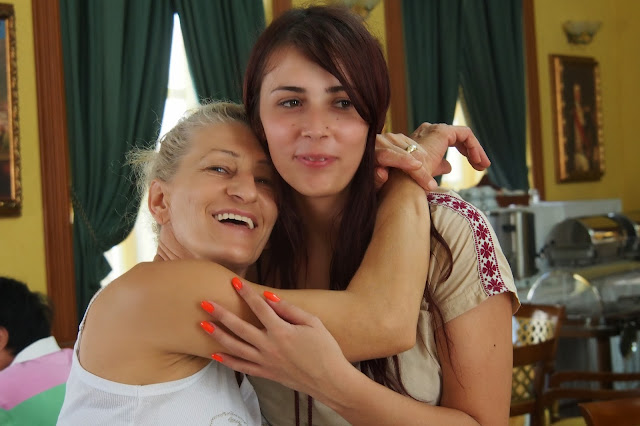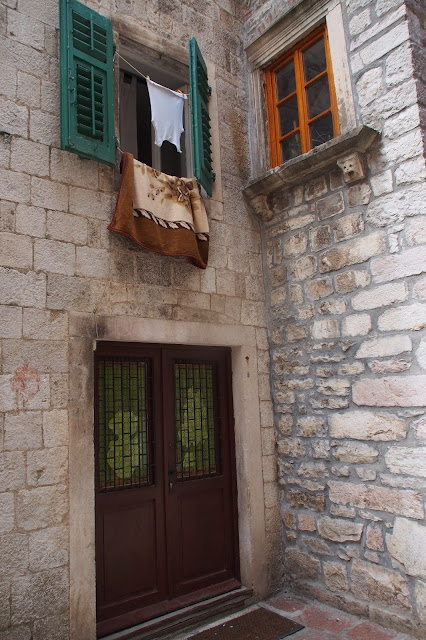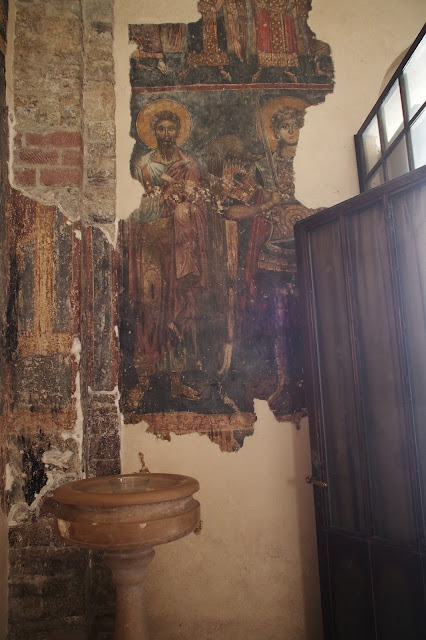After a tiring day at Dubrovnik, we had to rest.

We were taken to our hotel, a small but comfortable one with a nice courtyard full of sculptures.
the same after a bath
the same with a glass of wine, not just grapes
Another lady with what looks like a calyx on her hands
And even a stork!
Our hotel with its sculpture garden
its swimming pool
Our dining room
The logo of one of our local cooking oil company guarding the entrance to our rooms !
Light playing upon my bathroom
Light at the end of the corridor to our hotel rooms
After a good night's sleep, we're on the road again
The clouds look as if they all came from one point
The sea with a cruiser
Two boats, one with sail, another with an outboard engine
Some people had the sea all to themselves
Mountains we passed by
A wood in the distance
We had to cross the border from Croatia into Montenegro
A low mountain pass
The view from our rest stop
this photo from the rest stop stall is specially taken for the benefit of my male friends
She seems to be enjoying favors from two men
Not this unlucky one. Really?
More clouds
Another mountain road
an inland sea
We're still in karst country
See how craggy they look: the rocks all gnarled together
The clouds seem in two minds: concentrated and dispersed
The same moat from another angle
We were given a tour of this old seaside town. This is where we were supposed to meet after the tour


This 17th Century pyramid is a pillory. In old Europe, when someone did something considered wrong, he/she would be made to stand in front of this public pillory to be mocked at by the other towns people for some hours or a number of days!
But first, we were to have our lunch
Before that, some steps to climb

the corner of the reception area on the first floor, where our lunch would be awaiting
The appetizers
Our main course
Our dessert
Our waitresses, the elder one seems so happy, the younger a bit shy!
after filling our bellies, we were taken for another feast, for our eyes and our minds
First the town square: The Square of Arms of Kotor. We were told that Kotor Old Town (Cyrillic: Котор and Cattaro in Italian: Cattaro) is a coastal town in Montenegro at a bay of the same name , the Bay of Kotor (Boka Kotorska) with about 5000 odd living there and with a population of slightly under 13,000 including its sister town Dobrota a short distance away by the sea. It's a ria or submerged river canyon with many tourists brought there by cruisers. Since 1979, it been included as part of UNESCO's Natural and Culturo-Historical Region of Kotor. In Roman times, the old town was called Ascruvium, Ascrivium, or Ascruvium (Ancient Greek: Ἀσκρήβιον) and formed part of the Roman province of Dalmatia. Like so many places in the Balkans, it has a checkered history and underwent many changes of rulers. It was plundered by the Saracens in 840 and in 1002, then taken over by the First Bulgarian Empire which then immediately ceded to Venice by the Bulgarian Tsar Samuil to Serbia but the local population resisted until 1184 but it retained its republican institutions and the right to declare war and sign treaties with other nations and when Serbian influence waned, from 1420-1797, it was part of the Republic of Venice's Albania province and quickly became one of 3 most important trading cities in the Adriatic, along with Regusa and Venice. It was taken over for brief periods by the Ottoman Turks in 1538–1571 and 1657-1699. Four centuries of Venetian domination have left its mark in its typically Venetian architecture, something that contributed to make Kotor a UNESCO world heritage site. It suffered a plague in 1572 and was nearly destroyed by earthquakes in 1563 and 1667.During the Napoleonic Wars, it became part of the French supported Kingdom of Italy and in 1810 became directly held by France forming part of its Illyrian Provinces but after some fierce naval attacks by Britain, surrendered in 1814. At the Congress of Vienna, it was given to the Austria and remained under its control until 1918, when it became independent. During WWI, it became a naval base of the Austro-Hungarian Empire and the area became the site of some of the fiercest battles between local Montenegrin Slavs and Austria-Hungary. Between 1941 and 1943 Kingdom of Italy annexed the area of Kotor as one of three provinces of the Italian Governorate of Dalmatia but after 1945 it became a part of the then Socialist Republic of Montenegro within Yugoslavia's second incarnation. The city was hit by an earthquake in 1979 when half the town was destroyed. Kotor is one of the best preserved medieval old towns in the Adriatic. Together with the nearby old city of Budva, it hosted the Federation of European Carnival Cities (FECC) World Carnival City Congress in May 2009.In the mid-1800s the city had a mixed population of 1/3 Serbians, 1/3 Croats and 1/3 Italians but since then the Italians have nearly disappeared it is mainly occupied by "Montenegrins".
all life must run around the clock
Many of the houses are built around a forecourt
I walked inside one of them and this is what I found
Many of the historic buildings have been converted into shops, bars, cafes or tourism related shops
One of the bars
The open areas are colonized by nearby restaurants
A few tents, a few long table and benches and you're in business
Even spaces in front of one of the cathedral are not spared
A spacious house
Access to the first floor is external
An old fashioned drug stores called Aphrodita: anything to do with aphrodisiacs?
Transport within the Old Town can be quite primitive
Italian arched doors
Medieval types metal doors
there were many such small squares between houses
A poster advertising a wind and brass ensemble
The sign for a music school established since 1842
The locals like to pin posters on their walls
Two girls sitting in front of their souvenir stall
Like women everywhere, they'd place their laundry at whatever empty space they could find
A small shop selling T-shirts
This little lady is preparing her own little stall for selling her shells: Now where should I put this little string of beads?
Another shop sign outside the buildings
The window of what looks like an abandoned house
More colorful laundry
More laundry
much of the original paintings on the mural on the walls of this church has peeled off

But the structure of the church has endured
An orthodox church.
its interior
An inscription outside of the church
Another inscription. What does it mean?
 |
The Cathedral of St. Tryphon
The water from the mountains are regulated
various shades of green
The water is quite shallow
The city walls are not too high
The water is full of fungi
They give the water the appearance of a kind of freshness it wouldn't otherwise have
One of the bars
A shop selling paintings
Musicians have to live too: food for the ears of tourists
What would you like to have messieurs?
What is this doing in square? The structure for holding up another canopy?
there's another old church in up the hillside too: the Church of Our Lady of Health
These young students are having a good time visiting this Old Town
A pretty mixed groups, from 4 or 6 year old to teenagers
What on earth is that?
What is she doing?
Now, time to move on, girls. Make sure you remember where we shall meet again after the tour.
The fort on the hill top, built by the Roman Emperor Justinian in 535 AD after he expelled the Ostrogoths.
The entrance to the Old Town
A closer look at the entrance with tiled floor. On the arch at the entrance is the motto: "What belongs to others we don't want, what is ours we will never surrender."
The protectress of the town?
The town logo
Some cruisers moored along the quayside
a 120 footer yacht
A last look at the city wall before we boarded the tour coach
Ah, never used this angle before!
The hill looks steep and rugged. To the left is the Church of Our Lady of Health.
There were walls and watch towers at every level
Whoever controls the mountain top controls everything below: cannonballs and nowadays, mortar or artillery shells could be launched from there!

We're on our way again, to another seaside town.






































































































沒有留言:
張貼留言